Architecture, Sculpture and Painting of the First Goetheanum
GA 288
5 April 1920, Dornach
Translated by Steiner Online Library
IV. The Symbolism of the Building at Dornach II
I would like to start by talking about the principle of development, which I already hinted at yesterday. I said: If we follow the metamorphosis of forces within a developmental series, we first come from the simple into the complicated. So I want to draw a simple [it is drawn]; then a next more complicated one would perhaps be this; then we would come to a third, to a fourth, which would be like this (Fig. 105). Now we might have four stages of development of the same thing.
Now the next one could be somewhat more complicated than the previous form. We would then perhaps get this [fifth] form. But this would not come out, instead this other form will develop. What I have drawn with the thick line, that would then perhaps be visible on the outside. And if it were a real form in nature, one would then progress from this to this form. And yet it is only in the etheric that development continues in such a way that the more complicated forms, which I have indicated with the dots, emerge, while the physical, the externally visible, that which reveals itself again, perhaps simplifies itself again.
The next forms would then perhaps be such that the ethereal forms would be these [sixth]. But it is not this ethereal form that comes to the fore, but rather what remains visible on the outside is this [the thick line], which in turn is a simplification, an essential simplification, so that if you just consider physical development, you go from a stage of 1-2-3-4 in complication, then in simplification. This is also really the principle of development in nature.
For example, we can see how, let us say, the eyes of certain lower animal beings – considered physically and externally – are more complicated than the human eye. Certain lower animals have blood vessel-like organs, a “sword-shaped process” and a “fan” in their eyes. These are also disappearing, and the human eye is relatively simpler in its outward form, but the etheric body has a more complicated form. We can only grasp the principle of evolution correctly if we present it in this way. The principle of development is correctly captured in the evolution of the columns, capitals, architraves and bases that you were shown yesterday.
If you want to understand our building, you also have to bear in mind that the entire treatment is appropriately designed for the new architectural style in terms of character. It is the case, for example, that even the artistic treatment of the wall is different from the way walls were treated in earlier architectural styles: the wall was always conceived as the boundary of the space that one wanted to close off. Here at the Goetheanum, the wall is conceived in such a way that it actually overcomes itself. This is physically achieved in our windows. Our windows, in so far as they are the main windows of the auditorium, are etched out of single-colored glass panes. It is then the case that the artistic works are actually only created by the sunlight shining through. So the processing of the window panes is a preparation, and the whole impression is created by the interrelationship between what has been worked on the pane and the sunlight shining through. In the windows, in particular, what has otherwise been striven for in the entire building has been physically achieved, whether through the design of the columns, the carving on the walls, or the painting: the wall virtually dissolves. So that when you look at the wall, you don't have the feeling that the space is closed off, but that you have the feeling that you are being led out into the cosmos through the wall. With the windows, you must have this feeling physically, because you lead directly, I would say, to the effect of light on the outside, purely through the physical design of the panes; but with the other wall designs, this has also been attempted artistically.
This will give you an idea of how a new stylization of building forms has been striven for here, down to the last detail, how the formal language of our building is to be a new one, so to speak. It is understandable that philistinism cannot immediately comprehend this new design language, my dear friends. Now, it is important that we first show you some of what has been achieved with painting. First of all, I will show you the painting of the small dome, because I only have pictures of it here for now.
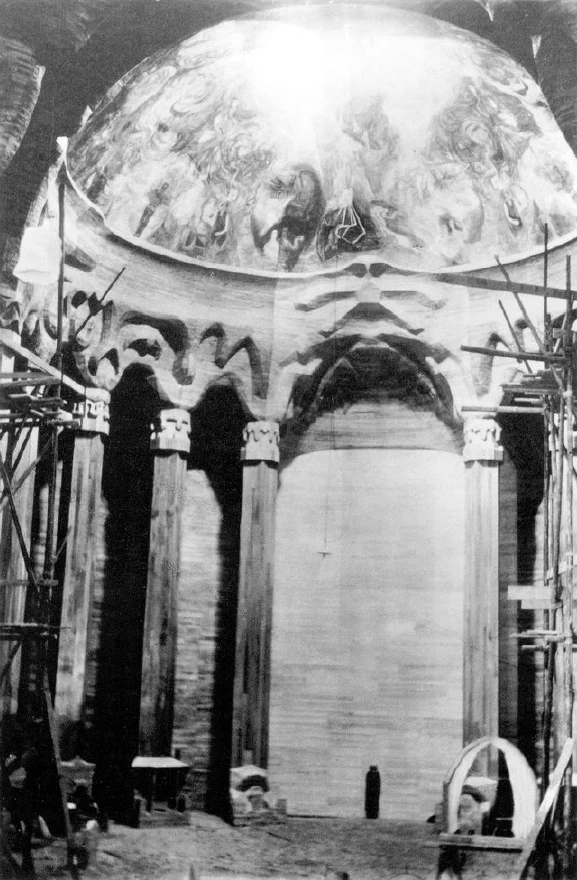
Let us look at what our revered friends actually saw. By visualizing this now in non-colored images, we must immediately point out that the essential thing about the painting of the small dome is not the motifs, but the bringing out of the motifs from the colors. There lies, I might say, the very beginning of what painting of the future will have to bring. Man will indeed have to understand more and more that in the details of nature, in essence, there is always something essential. For example, when you immerse yourself in a color, or in a color combination, it is not just this color combination that is present, but the color itself is something alive, something that works out of itself, and it is possible to educate oneself, for example, to live with the color blue. You will then get the feeling that the blue color gives you the impression of the designed, the moving, that which moves or is formed in space. So if you approach it in a creative way, you will get something that you draw out of the blue. The red or yellow gives you the impression that it wants to reveal itself, come towards you, talk to you. While the blue glides past you, the red gives you the impression that it comes towards you.
In this way, being with a color, but especially with many colors, can be invigorated. And all these things actually are in the work of nature. And only someone who educates himself in this immersion in the elements of nature can understand this. Therefore, it is somewhat striking when, let us say, in the current, indeed, in itself quite justified new striving for art, things come across that actually show that one has come out of imitating nature and, isn't it true, into something that one is actually striving for new artistic things in the inartistic. When we see that all manner of expressionist and futurist and so forth things are put together in any old way, or put together differently, what appears in nature in a certain way, then very often – not always, of course – there is something very unjustified in such a combination. For example, someone who forms a human eye cannot help but place the second eye in the right place if they do not merely see, but if they know how to live intimately with the creative forces of nature. This is because the eye is not something in itself, but only exists with the second eye. But one only comes to the inner essential creation of nature when one can live with the entities of nature, for example with colors.
And now, look, how could it not be possible to create from color itself? I just want to know when someone says: I am not interested in something created according to the model, but I am interested in applying the colors, I just want to know why then the form should not emerge from this pure application of the colors as the creature of the color. We have to get away from the model again. We have to get away from being tied to the naturalistic. Art has worked on that long enough. But we have to be able to develop an interest in seeing a light surface simply as a color spot and seeing a dark surface as a color spot. I would like to know how, when you simply have a light and a dark surface in an arrangement [it is drawn], how you could not feel a face turned in this direction, surrounded by hair growth here (Fig. 105).
Everything can be brought out of the color combination. Just as everything can be brought out of the treatment of the surface, of the treatment of the form in sculpture. In contrast to color, if painting wants to work with color, the line, the drawing, is actually an untruth. Because, you see, the horizon is not really and truly present as a line. That is not true at all. It is not a horizon line. What is real is the blue sky, and below it perhaps something shaped by nature, and that borders on each other. It is the contact of two colored surfaces. Whoever draws the line is lying. Whoever paints two colored surfaces, which of course must then have a border, is telling the truth. And it is with things like this that one begins to get used to the truth. Because we, wanting to be naturalistic, have lied so much artistically, that is why we also have the plight that so many lies are currently being told in the other world contexts.
Just think what, let us say, for example, the drama has achieved. Drama, at the end of the 19th century, in the culmination of materialism, began to be materialistic as well. There were people sitting in the auditorium watching dramatic performances of Arno Holz or Gerhart Hauptmann and so on, and now they didn't have something dramatic in the old Shakespearean, Schillerian or Goethean sense, where great series of events that are far apart are summarized, but a back house, a front house, or something like that, which was to be recreated in a very naturalistic way. The people should not talk about anything other than what is usually talked about in three hours. What kind of naturalism is that? It is the naturalism that, just like today's natural science, only takes into account the extra-human, which also, in the artistic, only takes into account the extra-human: can it be seen? If you wanted to be a model for a drama, you would have to remove the third wall so that everyone could see inside; then you could see what happens in three hours and recreate it from the stage.
These things are of course not taken into account at all in the age of naturalism, and one does not find the possibility of really placing the human being back into the whole natural and cosmic context. But this must also happen in art. It is understandable that art has long adhered to the model; but now the time has passed when art can adhere to the model. Art must grow together with the creative forces of nature and work out of the creative forces of nature. For what is the point of recreating nature in a naturalistic way? Whatever is created in a naturalistic way can never be achieved by nature. Every smallest achievement that is made out of something that is not there in the senses can be more significant than anything that appears to be so perfectly created in nature. If you want something realistic, you can say that you are sticking to nature itself. And in addition, in many areas naturalism was even somewhat extraordinarily frivolous. One thinks of Hauptmann's “Weavers”: the well-fed people sat down in the theater to overlook the whole series of scenes in Hauptmann's “Weavers”. This was called “social art”, bringing the misery of life into the theater, something frivolous, a frivolous cultural phenomenon. So we have to turn to the supersensible again. Today, people find it difficult to decide to enter the supersensible in art. But it will not become light in humanity if we do not decide on something like this in all areas.
Because the small cupola room is painted, the motifs are only the novellistic, not even the truly pictorial, artistic. But you have seen the thing itself, and so you might remember, especially in the pictures that I can show here, what you saw. It is perhaps even interesting to note how what is on the dome wall there cannot be reproduced if you only have the motif. But the motif itself, if you have it, must show that there is something incomplete about it. A motif that only appears in black and white is simply not satisfactory, because you have to be able to say what is missing. There must be something missing, because what is actually supposed to be depicted is areas of color, not black and white, and not lines, while what will appear to us is the novellistic element, the thought, which basically does not belong at all.
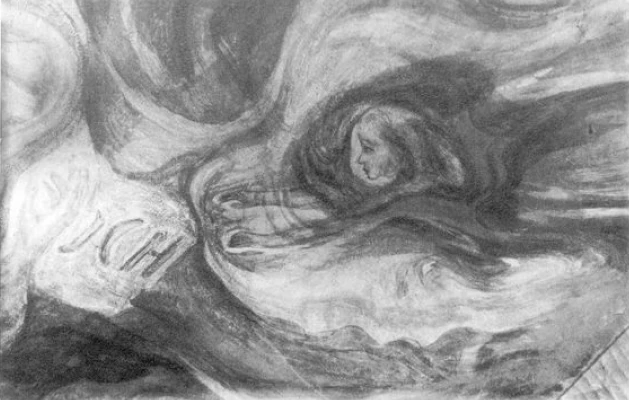
What you see here is what meets you from the small dome when you enter it. A child, emerging from the indeterminate material forms, flying towards the medieval figure, which has been captured by capturing a kind of Faust figure. It should be captured in a certain sense, the initiation of the Middle Ages. After humanity had gone through the most diverse forms of initiation, this initiation of the Middle Ages came about with all its tragedy.
It is indeed the case that, according to the spiritual conditions of this stage of human development, the human being cannot rise to an understanding of the living unless the realization of death stands beside it. To see through the connection between life and death is what leads, ultimately, from the Middle Ages to our own day, and through it to true knowledge.
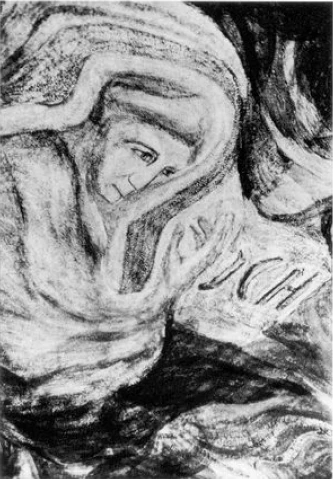
In the next picture you see here that which lies further to the east: this medieval initiate himself, who comes to his realization out of reflection, out of turning away from the world. But precisely if we want to experience this turning away from the world, we must experience it by acquiring an understanding of the forces of death that are out there in the whole world. And these forces of death are intimately related to our powers of consciousness. The same thing that confronts us in the human skeleton, that, my dear friends, that is the external image of death, at the same time expresses in external physical form what lives in our nervous system when we experience the reflective consciousness of modern times.
The consciousness of the early Middle Ages and especially the ancient consciousness were such that they did not depend on the human being dying in every moment of their waking lives in order to think. But in return, human beings were filled with images and imaginations in their consciousness, even if they were atavistic. Intellectualism has only developed since the middle of the 15th century. It has developed because our head organs have assumed a formation that, when it takes hold of the whole person, continually leads to death. A battle between life and death is constantly taking place in the human being. The head wants to die. This is prevented by the life forces that continually surge up from the rest of the organization.
This dying of the head, to which we owe our intellectual consciousness, is what should also be expressed through all the colors and everything that has been brought out of the color in this form. This is the only place where the letter, the written word, appears within our entire structure, and rightly so, because it is only in this time that the I, the I-thought of humanity, has become so abstract that it can be pointed to with letters. The I-thought will only be able to be borne more and more by the fact that this I is indeed filled with the Christ. That is why medieval mysticism had the task of developing the Pauline word through a whole series of sermons and reflections such as those of Johannes Tauler and Meister Eckhart. It is fixed for all eternity within the medieval language, which developed in the German-speaking areas after the modern era, that the I: written out, the initials of Christ Jesus: ICH;
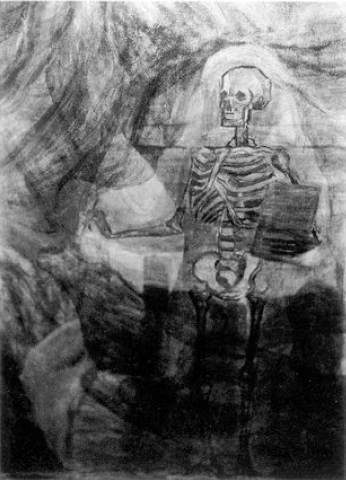
For the reasons I have just explained, you see Death beneath the Faust figure; this Death comes from forces that work from the center of the Earth towards us and combine only with the Mercury forces that work from the cosmos towards the Earth. The sight of the Faust-like figure with Death below him would be unbearable if the counter-image were not created in his perception, in the child flying towards Faust and the ego.
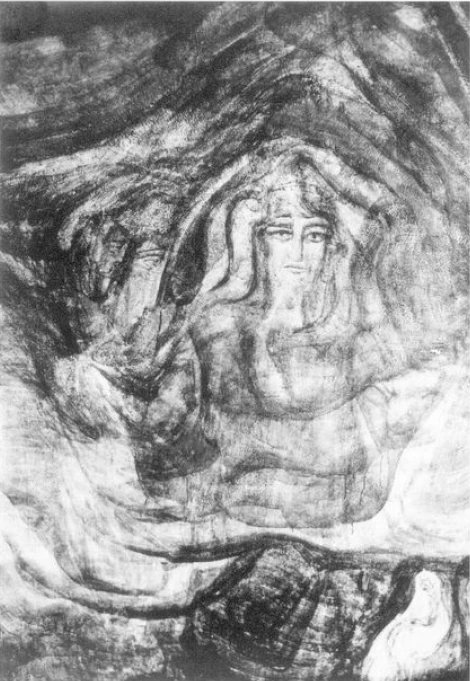
The next picture shows us the Greek personality as she lives under the initiation, a more feminine figure, since in fact the Greek initiation spoke more to the feminine. In general, in Greek high culture, the content of the initiation had to be gained by the initiate acquiring what female figures, who to a certain extent intervened in the flow that comes to man from the cosmos, what could be gained from such female figures: The Pythian priestesses in Greece are intimately connected with the whole structure of the Greek initiation. So that then such things appear as these heads, for example, which are worked purely from form.
This already invites us not to ask in the abstract sense: What does something like this mean? This question is an unartistic one when posed in abstract form. At this point, one must look at what color is there and how, according to the principle that I have just explained here, the shapes themselves emerge from the experience of the colors. Everything that belongs to this figure has actually come about in the end through the perception of the colors.
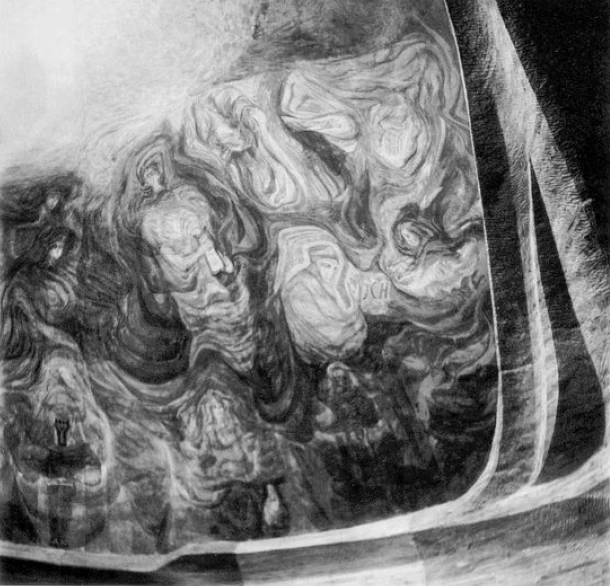
The next picture: you have a larger area to see here, here is the flying child seen earlier; here the small dome connects to the large dome; then this figure of the medieval initiator, and here is death. And here is the figure you just saw, above it the inspiring figure, an Apollo-like figure. Unfortunately, the picture is very imperfect. And at the top there is still the higher inspirer.
In these pictures, there is always what is initiated as a personality. Above it, there is the figure that sinks the imaginations into the personality to be initiated, and above it, there is the figure of a higher hierarchical order that sinks the inspirations into it. So here you have the inspiring figure, which is above the Faust-like figure.
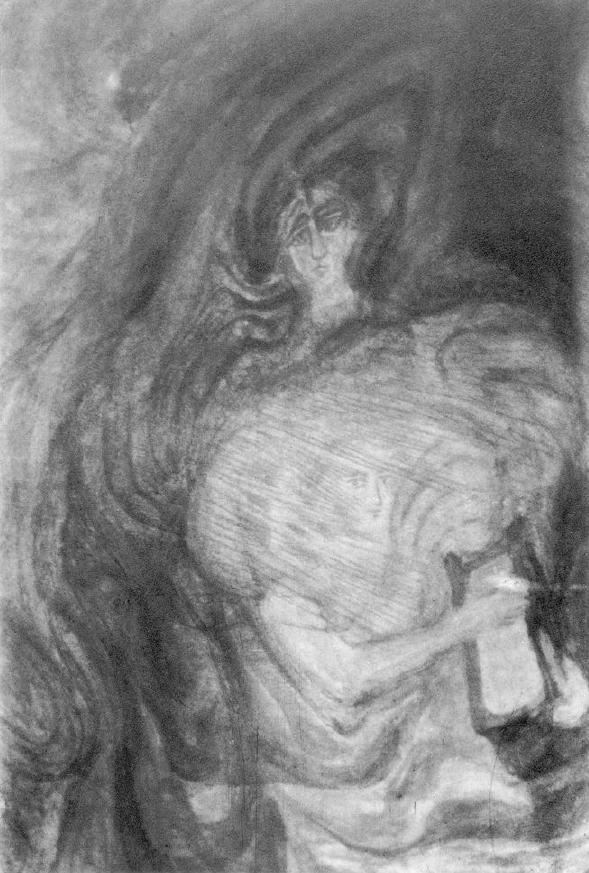
The next picture is unfortunately very unclear. This is the inspiring figure that is above the Greek initiator. If you imagine the one you saw earlier, with the three heads on the shoulder, then this is the figure above it, the one who lets the imaginations flow into the lower figure, and above that the inspirer of the heads of the inspirer. Here is the head of the inspirer, and below that would be this Athena-like figure, who inspires and is inspired and imagined.
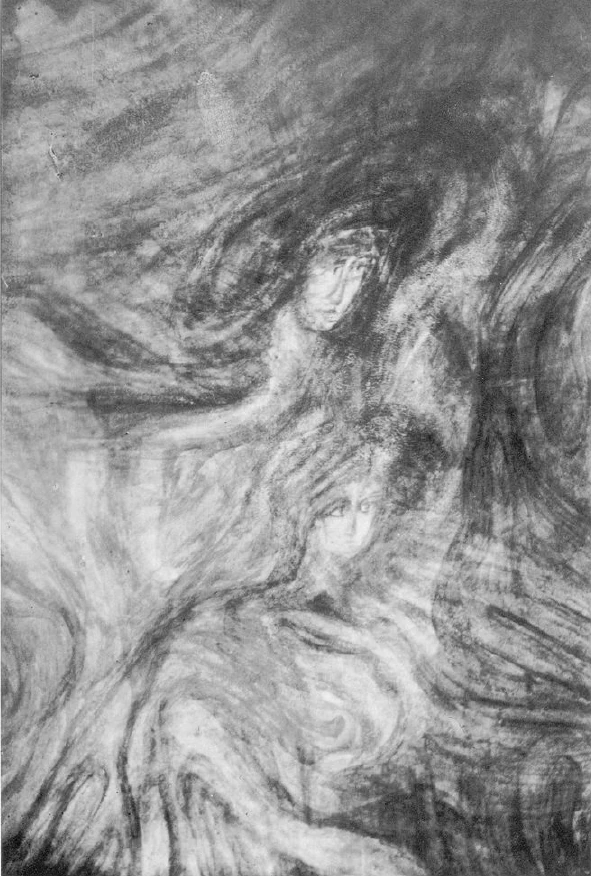
And here you have the two figures. The figure at the bottom is that which sends the imaginations down into the Egyptian initiates, and the other figure is that which allows the inspirations to flow into them. And as we move forward, we come to the representation of Egyptian initiation.
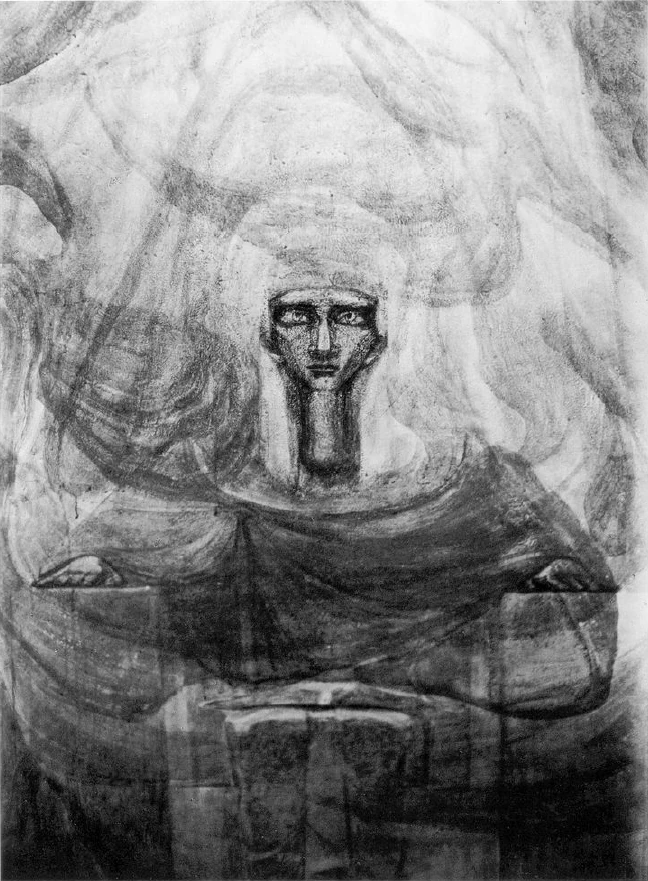
So the next picture is the Egyptian initiates; above him are the two figures that have just been seen here.
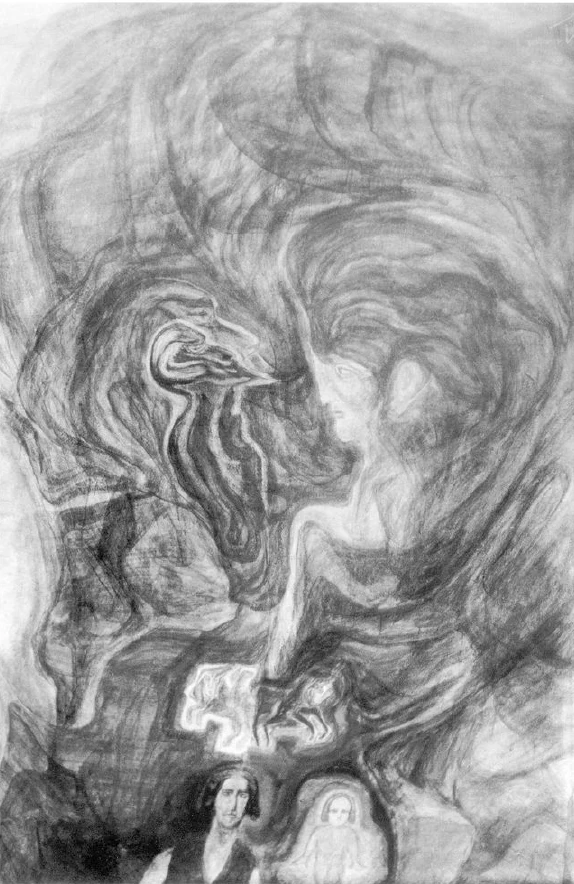
And so we come to the older Persian-Germanic initiation. This Persian-Germanic initiation is still effective in our time, but it has, as it were, something enclosed within it, the medieval initiation mentioned earlier, that is, the one characterized in the first figure. The medieval initiation is, as it were, shorter, and this one encompasses the whole long period. What matters in it is that the duality in the world - the bright, Luciferic, the dark, Ahrimanic - be seen through in its entire effect on the world. Here you have on the one hand the dark, Ahrimanic: the small head is in fact Ahriman, the other is his shadow, which he carries with him. On the other side: the Lucifer figure. You can see how this is developed in the sculptural group – you have all seen the group. So you can see how the contrast between the head of Ahriman and the head of Lucifer confronts you. And in the painting, one could also clearly express this mutual relationship between Ahriman and Lucifer.
If you see, for example, how the forward thrust of Lucifer's forehead virtually takes away Ahriman's foreheads, or how Ahriman's foreheads are hardened towards the back, then you see the interplay as it is the organizing force of nature. This then goes down. You see how a kind of centaur shape corresponds to Ahriman – a kind of centaur shape also corresponds to Lucifer – that they are connected to each other, want to be apart and cannot, complement each other in the colors, and below that the Persian-Germanic initiate, who carries the child floating on his hand, pointing out how the future and the hope for the future must be taken up in man by seeing through dualism.
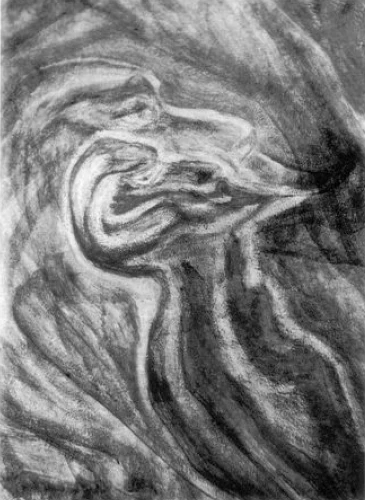
The next image: Ahriman is alone with his shadow. The Ahrimanic is therefore everything in man that works in one direction in man. The human being is so essentially that man constantly strives to keep the balance between the Ahrimanic and the Luciferic in him. The Ahrimanic is everything in us that, if we take the matter spiritually, inwardly, strives in us for the sober, prosaic, materialistic, for the philistine, for the bourgeois, for the tantric. That is the Ahrimanic, that which hardens man, that which solidifies man within himself, which prevents him from opening up to the world, which makes him absorbed in his egoism. It is that which draws man to the earth, physiologically speaking, it is that which works in man and by which he would actually be continually exposed to the danger of succumbing to hardening, to sclerosis, to ossification, if it were not for the reciprocal, the Luciferic. He would be constantly in danger of becoming diabetic, for example, or of developing terrible gouty lumps. That is the Ahrimanic. Ahriman suffers greatly from constant gouty lumps, from constant rheumatism, etc. There are things that are physiologically connected with the soul-like philistinism, materialism, bourgeois conformity, and so on, as I characterized it earlier.
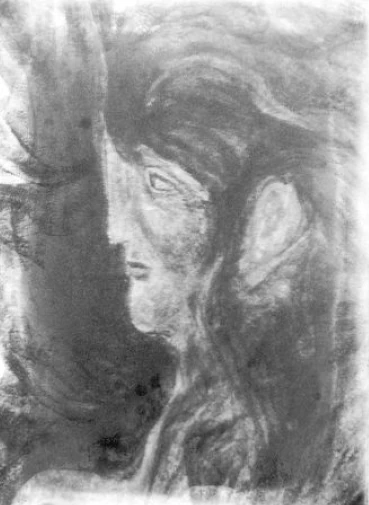
This is the Luciferian figure, the complete opposite image. It is the other side of man, that which continually causes man, in his soul, to stray into the mystical and the fantastic, continually causes him, as it were, to be a being that wants to get beyond the human head. All enthusiasm in man is that which is striven for by the forces that are, as such, Luciferian in man.
Now there are two ways in which these contradictions can be present in human nature: One is that man strives to achieve a kind of equilibrium, that is, to facilitate everything that strives within him towards the philistine, the bourgeois, by also developing imagination, by also being able to devote himself to the world, and by also understanding how to bring the artistic into the purely abstract. That is to say, it is possible for a person to achieve such a balance of these two opposing currents that the person becomes one through the two harmoniously blending into each other and becoming one.
But the other is also possible, that the two extremes continue to work in man, so that man does not find a balance in which they flow into one another, but that the two things are active in him. For example, you can meet mystical enthusiasts who ascend to the highest theosophical, symbolic regions, always wanting to rise above their heads, but in ordinary life they are philistines. Loving everything philistine, pedantic, materialistic, tough and so on - yes, tough! - goes quite well with mystical enthusiasm in a person. This, so to speak, obscures the balance deep within the unconscious. There, what is actually a twofold nature comes out in dualism. So in some ways, these two sides can also be present in a person, revealing themselves. One is not a philistine just because one is a dreamer. One can very well be a philistine and a dreamer at the same time. Figure 13 (Fig. 80):
There you see the one who is inspired by the insights of the interaction of the dark and the light world, who must connect what is indicated by the child's hovering.
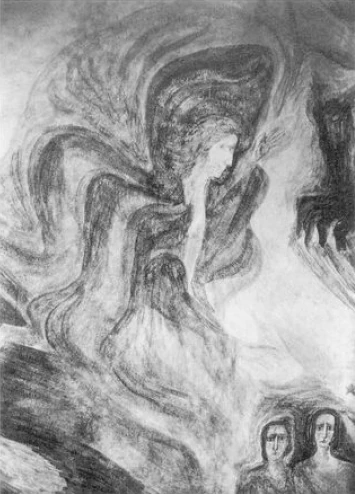
Here you see that which is already there in a certain way as an initiation principle, but which will only have its task in the future: the way in which the secrets of the upper world can be received in Slavic countries today, a kind of Russian figure that has its own shadow beside it, as so often the Russian invisibly carries its own shadow with it, always has its shadow beside it. What is inspired from above, we will then see more clearly. A centaur figure, something that is already humanly shaped or already superhumanly shaped. There is no need to decide this question, but rather to think in terms of form. In between, as a counter-image, the angelic form. Just as we have Ahriman and Lucifer in the present culture, the Germanic-Persian one, so here, where we go a little further, we have the human form, stuck in the animal, and a superhuman form as its opposite.
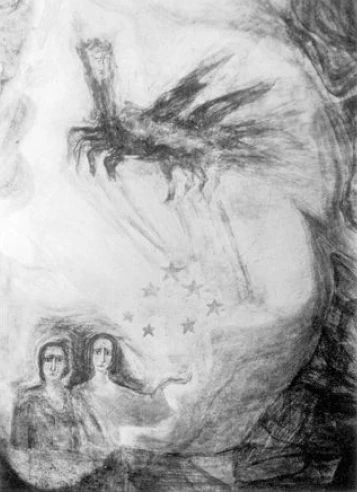
You see here above the figure still reminiscent of the animal, so to speak the animal transported into the world of the stars, the animal having become ethereal, which contains within itself the forces of initiation for this future time, when these forces on the other side – these forces, which are more of an Ahrimanic nature – are held in the balance by the superhuman, by the angelic, which approaches this figure from the other side.
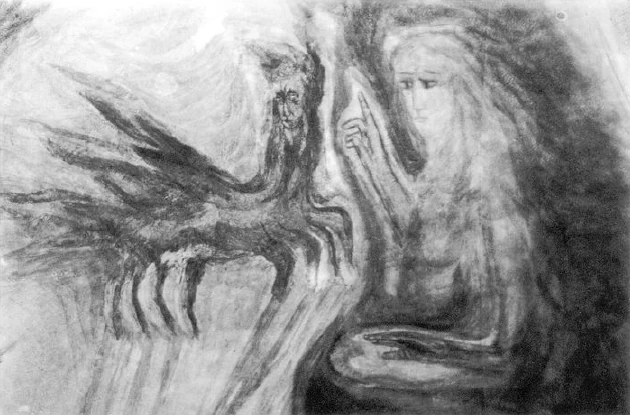
Here you have the angelic form together with the animal form, but it is something that is ethereally animal and ethereally superhuman. It is the interaction of the mysteries that work in one form or another that will bring about the initiation for the coming age.
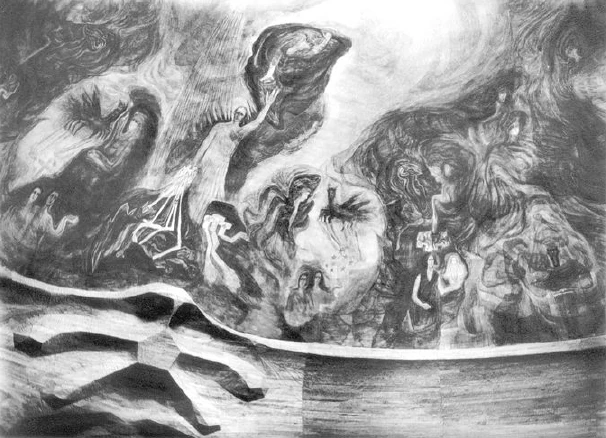
The next picture: Here you have once more, so that you can see more of it, the initiating and the initiated. Thus, an attempt has been made to put together in the dome that which leads to the knowledge of the supersensible from the most diverse human conditions - Egyptian, Greek, medieval, past, future - and from the most diverse temporal conditions. And all of this is worked out of color to such an extent that one can have the impression that the wall is destroying itself, destroying itself with something that actually has no end in the soul, that enters into the spiritual; so that the wall, through its artistic design, cancels itself out.
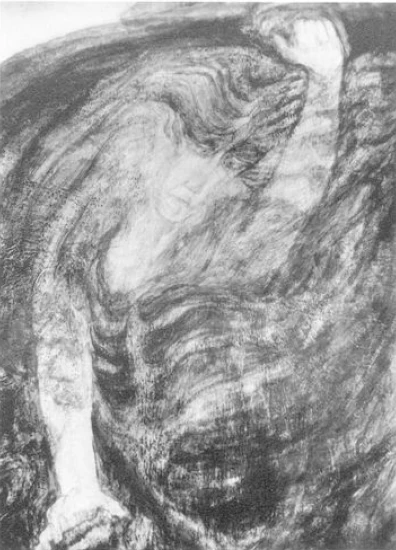
Here you see the Luciferian figure as it is in the central figure; here is Christ. You will remember that you saw it over there in the building: it is in particular red color, worked out of red and yellow. I wanted to distinguish it from the other colors; so that the whole – if one may say so – the Luciferian experience – is a red-yellow experience, from the burning, phosphorous color, from the hot color, everything that leads people to want to rise above their own heads.
Everything that is otherwise in the dome and in the building in general is as if synthesized in this eastern group, in this Christ-like figure in the center, Lucifer above it, Ahriman below it, which is then completed in the rock group below. The whole mystery of man is there as a mystery: Christ, Lucifer, man, Ahriman, and thus there is a continuation of the building idea, which was found in its various metamorphoses from ancient Greek, Gothic times to our own. The Greek temple, as a dwelling for a god, had only one meaning in that it enclosed the god. One cannot imagine its forms of construction other than as the dwelling of the god. The medieval Gothic cathedral only has a purpose if the community is in it, otherwise it is abandoned. Its walling indicates that it only has a purpose if the community is in it. Inside, there should be that which leads man to self-knowledge, which presents man to himself, what man is: a being that has to seek the Hypomochlion between the Luciferic and the Ahrimanic.
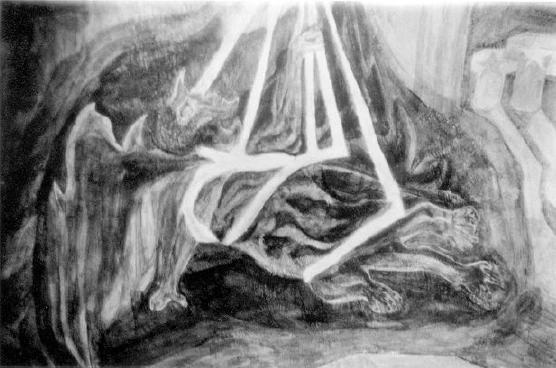
In the next picture, you can see below it the Ahrimanic, which is struck by the rays of fire emanating from the arm of the Representative of Humanity - the Christ Jesus. The Ahrimanic is also held fast by the forces of the earth. It is everything that pushes the human being towards the earth, the heaviness of the earth in the human being, just as the Luciferic is that through which the human being wants to move away from the world. The Ahrimanic: the inward brokenness, the inward heavy suffering. The Luciferic: that which leads the human being to stupefaction, to illusion, to hallucination. Here with Ahriman, everything bony, everything hardening. In Lucifer, everything feverish, pleurisy-like, etc., everything that, if developed one-sidedly by the human being, would cause the human being to burn inwardly through his joy and lust and greed and desire. The Ahrimanic: that which freezes within in pain and therefore endures infinite pain when the rays of fire come over its coldness.
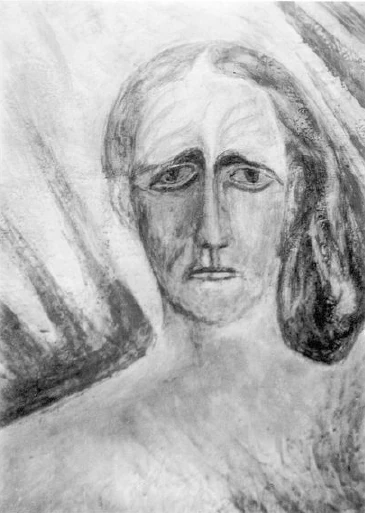
The next picture: the head of the Representative of Man, as I believe it can be fully captured in spiritual science. The usual image that one has of Christ - it was actually only in the sixth century that the bearded Christ emerged - the history of Christ portraits is extremely interesting. The Christ portraits emerged from lively discussions about whether Christ was beautiful or ugly. Of course, these discussions took place at a time when there was no longer a living image of Christ. Then the urge to capture Christ in pictures arose at a time when people could no longer depict beauty in the old Greek sense. We have to try to see Christ spiritually. And as far as I believe I can advocate the matter, it is – precisely by transforming the whole into the spiritual, which can only be seen in what has been preserved in the Akasha Chronicle – the figure of the one who really walked in Palestine at the beginning of our era. But this should not be taken as if there were a portrait study, but it can be felt that the representative of humanity is also connected with history in this way. Everything must follow from the artistic intuition itself.
Now I still have a few figures in the next picture: you see the middle group here. Here the Russian initiation, above it the angel, the centaur; then this Golgotha Way, the threefold path, to Christ, to the two thieves or robbers. Here the Ahriman figure, struck by the rays of fire, then the Christ figure, above it Lucifer. Here again the other side: the angel, the centaur figure, thus the initiating one. Below that, in turn, would be the two initiators that belong together.
Here you see the five-part leaf that I mentioned yesterday. Then you see the Germanic-Persian initiation, the Luciferic-Ahrimanic one, and then the Egyptian initiation. But this is already very unclear in this picture. You can still see the Egyptian initiate. An attempt has been made to photograph the object in a variety of ways. It is of course true that photography can only give the motif in the most diverse ways, which is basically not what it is all about.
I would also like to mention that our building, the double-domed structure, is covered with Norwegian slate. Once, when I was on a lecture tour that took me from Kristiania to Bergen, I looked out of the window of the railway carriage and noticed the beautiful Voss slate from the Voss slate quarries. During that journey, I had the idea that it would be a good idea to use this Voss slate to cover our building – an idea that could then be realized. Those who look at the roofs of our building, as they shine, especially under certain effects of the sun in their grayish-blue, will see that this idea was indeed a justified one, to ship this Norwegian slate to the south just enough to cover this building. It does indeed reflect the sun's rays wonderfully, and the rays of light in turn.
Of course, I can only give a brief description of what was attempted in this building. If you combine what I have been able to discuss, because there are pictures, with what you will see in the future, along with many other things, in general and in detail, you will get an idea of how this building should become a hieroglyph, an immediate revelation in the forms and colors of that which lies in the entire anthroposophically oriented world view. It should be presented as a great hieroglyph to the present day. And something would really be done for our time and for the near future if this building could ever be completed. It has been started with a certain devotion to the cause, started at that time especially from those areas that are now confined to world life, that can no longer really contribute because they are completely impoverished in relation to the rest of the world. Events have brought it about that precisely these regions have become impoverished in the face of world events, which first gave rise to this idea of building, and it would actually be good if so much un-chauvinistic, pure humanity could arise in the world that this building could now really be completed on the part of those regions that have suffered less from the horrors of recent years. It should actually be completed.
However, if you look at everything that has been a motivating factor in the last five to six years, and if you see it continuing to have an effect on the winners and the defeated, if you see how nowhere does the realization dawn that a completely new situation must take hold, then there can be little hope that this edifice will ever be completed. But it is, my dear friends, a demand of the time, it is a demand of the future. It is something that should be understood quite differently than one has been inclined to understand it until now. And it would perhaps be the first sign of a manifestation of the will to heal the world if, let us say, an understanding were to awaken from the English, French, and American sides, precisely for the completion of this building. The first impulse came from Central Europe; the rest would have to come from those who were neutral in the last years or from those who were hostile to Central Europe, if there were real understanding.
But it really seems as if souls want to continue sleeping, as if most of them say to themselves: Oh, what's the point of getting involved in something new! Things will only turn out well if we go back to what was more or less the case until 1914. Many people long for that. My dear friends, that will never come back. And those who want that, and who are working to bring it about, those who cannot rise above the idea that something as new must come among us as the architectural styles of this building here are, they are working towards the downfall of humanity. Isn't it actually, I would say, heartbreaking in terms of the culture of humanity and its development, as Dr. Kolisko had to say here a few days ago, as he had to characterize, as it were, how at the turn of the 18th to the 19th century and well into the 19th century, the Goethe culture had emerged, and that this Goethe culture has completely dried up. It had already dried up in Germany by the 1880s.
Perhaps I may allow myself a subjective judgment in these matters, because I myself came to Weimar for the first time in 1889, then in 1890 to the Goethe-Schiller Archive. Yes, my dear friends, there we really were at the burial place of Goetheanism, at the real burial place of Goetheanism. And in that, there was no difference between the various nations of the world. There the German scholar, by cutting syllables, recalled Faust, together with Calvin Thomas, the American scholar, who cut syllables in the same way. People from all over the world worked there. Science had come to the point where it was far away, where it was concerned with Goethe. Truly, everywhere a cutting up of the living Goethean being, terrible, terrible!
In Austria, however, which already carried the seed of destruction within itself, which, through its state-political system, carried the seeds of destruction within itself, there were still a few isolated developers of Goetheanism, as Dr. Kolisko characterized it here in these days. Then, what once existed was finished, covered up! It is up to humanity itself whether the same fate that befell Goetheanism befalls all of European culture and its American offspring. It is hard to believe, but the question for humanity today is: Do you want something new and thus save the white race from barbarism, or do you want the same fate for the entire culture of the white race as for Goetheanism? And rising above this barbarism of the white race, what will the non-white races, namely the Negroes and similar races, bring about what is now the civilized world? 1See the reference on p. 159. The question today is: How many people are able to face this problem? How many people feel how serious it is today that it is a matter of the existence or non-existence of contemporary civilization?
This building was intended to be nothing less than a living expression of this. It is the continuation of what European culture has achieved, and this continuation should live, not die! But this building does not appeal to an indeterminate fate, to which one might comfortably surrender, but rather appeals to something actively alive. If people want to save European civilization without this active life, without this impulse for salvation, without this will, without this act of freedom, then this culture will not be saved, and will meet the same fate as Goetheanism in Central Europe. Then one might establish large archives and do philology in these large archives about what once was in Europe. But we should not let it come to archives alone; we should let it come to living buildings, both physical and spiritual, which already announce their liveliness through their forms. I would like that to be read from these forms. Because this name, Goetheanum, was longed for by someone, my dear friends, as the final name for this building here, which has already experienced the difference between a mausoleum of Goetheanism and what could be a living organism for the Goethean spirit, but in its further development, now for 1920, in fifty years for 1970, etc.
That is what I wanted to say to you today, following the description of the building.
Die Hieroglyphe des Dornacher Baus II
Ich möchte zunächst nachholend sprechen über das Prinzip der Entwicklung, das ich schon gestern angedeutet habe. Ich sagte: Wenn man die Kräftemetamorphose innerhalb einer Entwicklungsreihe verfolgt, so kommt man zunächst aus dem Einfachen eben in das Komplizierte. Ich will also ein Einfaches zeichnen [es wird gezeichnet]; dann würde ein Nächstkomplizierteres vielleicht dieses sein; dann würden wir zu einem Dritten, zu einem Vierten kommen, welches so wäre (Abb. 105). Nun hätten wir vielleicht vier Entwicklungsstadien derselben Sache.
Nun könnte die nächste ideell etwas komplizierter sein als die vorhergehende Form. Wir würden dann vielleicht diese [fünfte] Form bekommen. Diese würde aber nicht herauskommen, sondern es wird stattdessen diese andere Form sich entwickeln. Das, was ich mit dem dicken Strich gezeichnet habe, das würde dann vielleicht nach außen hin sichtbar sein. Und würde es sich um eine wirkliche Form in der Natur handeln, so würde man dann von dieser zu dieser Form fortschreiten. Und doch schreitet nur im Ätherischen die Entwicklung weiter so fort, dass die komplizierteren Formen, die ich mit den Punkten angedeutet habe, herauskommen, während das Physische, das äußerlich Sichtbare, das sich wieder Offenbarende, sich vielleicht wieder vereinfacht.
Die nächsten Formen würden dann vielleicht so sein, dass die ätherischen Formen diese [sechsten] wären. Es kommt aber nicht diese ätherische Form zum Vorschein, sondern nach außen hin bleibt dieses [der dicke Strich] sichtbar, was wiederum eine Vereinfachung, eine wesentliche Vereinfachung ist, sodass, wenn man bloß die physische Entwicklung in Betracht zieht, man aufsteigt von einem Stadium 1-2-3-4 in Komplikation, dann in Vereinfachung. Dieses ist auch wirklich das Entwicklungsprinzip in der Natur.
Man kann zum Beispiel sehen, wie, sagen wir, die Augen gewisser niederer Tierwesen - äußerlich physisch angesehen - komplizierter sind als das menschliche Auge. Gewisse niedere Tiere haben blutgefäßartige Organe, «Schwertfortsatz» und «Fächer» in ihrem Auge drinnen. Die verschwinden wiederum, und das menschliche Auge ist nach außen hin verhältnismäßig einfacher gestaltet, aber der Ätherleib trägt die kompliziertere Form. Nur dann erfassen wir das Prinzip der Evolution richtig, wenn wir es in dieser Art vorstellen. In der Ihnen gestern vorgeführten Evolution der Säulen, Kapitelle, Architrave und Sockel ist das Prinzip der Entwicklung in der richtigen Weise festgehalten.
Wenn man unseren Bau verstehen will, so muss man auch darauf Rücksicht nehmen, dass die ganze Behandlung dem im Charakter neuen Baustil angemessen gestaltet ist. Es ist so, dass zum Beispiel selbst die Wandgestaltung künstlerisch eine andere ist als die Wandgestaltung bei früheren Baustilen: Es ist die Wand eigentlich immer so aufgefasst worden, dass sie als Grenze des Raumes, den man abschließen wollte, aufgefasst wurde. Bei uns hier am Goetheanum ist die Wand so aufgefasst, dass sie eigentlich sich selber überwindet. Das ist physisch erreicht bei unseren Fenstern. Unsere Fenster sind, insofern sie die Hauptfenster des Zuschauerraumes sind, aus einfarbigen Glasscheiben herausradiert. Es ist dann so, dass die künstlerischen Werke eigentlich erst dadurch zustande kommen, dass das Sonnenlicht durchscheint. Es ist also die Bearbeitung der Fensterscheiben eine Vorbereitung, und der ganze Eindruck wird durch das Wechselverhältnis desjenigen, was an der Scheibe gearbeitet wurde, mit dem durchscheinenden Sonnenlichte erzeugt. Da ist gerade bei den Fenstern physisch dasjenige erreicht, was sonst angestrebt worden ist im ganzen Bau, sei es durch die Säulengestaltung, sei es durch die sonstige Wandschnitzerei, sei es durch die Malerei, dass die Wand gewissermaßen sich selber aufhebt. Sodass man, wenn man an die Wand hinschaut, nicht das Gefühl hat, der Raum ist abgeschlossen, sondern dass man das Gefühl hat: Durch die Wand hindurch wird man in den Kosmos hinausgeführt. Bei den Fenstern müssen Sie ja dieses Gefühl physisch haben, weil Sie unmittelbar, ich möchte sagen, zur Lichtwirkung nach außen führen, rein durch die physische Gestaltung der Scheiben; aber bei den übrigen Wandgestaltungen ist das auch künstlerisch versucht worden.
Das wird Ihnen einen Begriff davon geben, wie bis in die Einzelheiten, bis in alle Einzelheiten hinein, hier eine neue Stilisierung der Bauformen angestrebt worden ist, wie gewissermaßen die Formensprache unseres Baues ein Neues sein soll. Dass selbstverständlich das Philistertum nicht gleich nach kann mit seinem Verständnisse dieser Neugestaltung der Formensprache, das, meine lieben Freunde, muss uns ja etwas Begreifliches sein. Nun handelt es sich darum, dass wir zunächst uns noch einiges von dem vorführen, was mit der Malerei angestrebt worden ist. Da ist vor allen Dingen vorzuführen hier - weil ich nur davon zunächst Bilder habe - die Malerei der kleinen Kuppel.

Sehen wir uns dasjenige an, was ja die verehrten Freunde gesehen haben in Wirklichkeit. Indem wir uns das vor Augen führen jetzt in nichtfarbigen Bildern, müssen wir eben gleich darauf aufmerksam machen, dass das Wesentliche gerade der Ausmalung der kleinen Kuppel nicht die Motive sind, sondern das Herausholen der Motive aus den Farben. Da liegt eigentlich der erste Anfang, ich möchte sagen dessen, was voraussichtlich die Malerei der Zukunft wird bringen müssen. Der Mensch wird ja immer mehr und mehr begreifen müssen, dass eigentlich in den Einzelheiten der Natur im Wesentlichen immer Wesenhaftes liegt. Dass zum Beispiel, wenn man in eine Farbe sich vertieft, oder namentlich in eine Farbenzusammenstellung, dass dann nicht vorliegt einfach diese Farbenzusammenstellung, sondern dass die Farbe als solche etwas Lebendiges ist, etwas aus sich heraus Wirkendes, und dass es möglich ist, sich zu erziehen zum Beispiel zu einem Zusammenleben mit der blauen Farbe. Man wird dann das Gefühl bekommen, die blaue Farbe gibt einem den Eindruck des Gestalteten, des sich Bewegenden, desjenigen, was im Raum sich bewegt oder sich gestaltet. Man wird daher, wenn man gestaltend zu Wege geht, etwas kriegen, das Sie aus dem Blau herausholen. Das Rote oder Gelbe gibt Ihnen den Eindruck, als ob es sich offenbaren wollte, Ihnen entgegenkäme, auf einen einredete. Während das Blaue an einem vorbeigleitet, gibt das Rote den Eindruck, als ob es auf einen zukommt.
So kann belebt werden das Zusammensein mit einer Farbe, aber namentlich mit vielen Farben. Und alle diese Dinge sind tatsächlich in dem Naturschaffen drinnen. Und das kann nur derjenige verstehen, der sich in diesem Einleben in die Glieder des Naturschaffens erzieht. Daher ist es etwas auffällig, wenn, sagen wir, im jetzigen, ja an sich ganz berechtigten neuen Kunststreben doch wiederum Dinge einem entgegentreten, die eigentlich zeigen, dass man herausgekommen ist aus dem Nachschaffen der Natur und, nicht wahr, in etwas hineingekommen ist, dass man eigentlich im Unkünstlerischen nach neuen künstlerischen Dingen strebt. Wenn wir sehen, dass allerlei Expressionistisches und Futuristisches und so weiter in beliebiger Weise zusammenstellt dasjenige, anders zusammenstellt, was in der Natur in einer gewissen Weise erscheint, so liegt sehr häufig- nicht immer selbstverständlich - in einem solchen Zusammenstellen etwas sehr Unberechtigtes. Derjenige, der zum Beispiel ein menschliches Auge formt, er kann nicht anders, wenn er überhaupt nicht etwa bloß sieht, sondern wenn er mit den schaffenden Kräften der Natur innig zu leben weiß, der kann nicht anders als das zweite Auge auch an die rechte Stelle setzen, aus dem einfachen Grunde, weil das eine Auge gar nicht etwas für sich ist, sondern erst mit dem zweiten Auge etwas ist. Aber auf das innere wesenhafte Schaffen der Natur kommt man erst, wenn man eben mit den Entitäten der Natur, also zum Beispiel mit den Farben, leben kann.
Und nun, sehen Sie, wie sollte es nicht möglich sein, aus der Farbe selbst heraus zu schaffen? Ich möchte bloß wissen, wenn jemand sagt: Mich interessiert nicht irgendetwas nach dem Modell Geschaffenes, sondern mich interessiert das Auftragen der Farben, ich möchte bloß wissen, warum dann nicht aus diesem reinen Auftragen der Farben die Form als das Geschöpf der Farbe hervorgehen sollte. Wir müssen wieder loskommen vom Modell. Wir müssen loskommen von dem Gebundensein an das Naturalistische. An dem hat die Kunst lange genug gearbeitet. Aber wir müssen Interesse dafür bekommen können, eine helle Fläche einfach als Farbenfleck zu sehen, und eine dunkle Fläche daran als Farbenfleck zu sehen. Ich möchte gern wissen, wie man, wenn man einfach in einer Anordnung eine helle und eine dunkle Fläche hat [es wird gezeichnet], wie man dann nicht ein nach dieser Richtung hin gewendetes Gesicht empfinden könnte, das hier von Haarwuchs umgeben ist (Abb. 105).
Es kann alles herausgeholt werden aus der Farbenkombination. Ebenso wie in der Plastik alles herausgeholt werden kann aus der Behandlung der Fläche, aus der Behandlung der Form. Der Farbe gegenüber, wenn die Malerei mit der Farbe arbeiten will, ist eigentlich die Linie, die Zeichnung, eine Unwahrheit. Denn, sehen Sie, es ist ja nirgends das wirklich und wahrhaftig vorhanden, dass der Horizont eine Linie ist. Das ist gar nicht wahr. Es ist keine Horizontlinie. Was in Wirklichkeit ist, das ist der blaue Himmel, und unten vielleicht irgendetwas so oder so von der Natur Gestaltetes, und das grenzt aneinander. Es ist die Berührung von zwei farbigen Flächen. Wer die Linie hinzeichnet, lügt. Wer zwei farbige Flächen hinmalt, die dann selbstverständlich eine Grenze haben müssen, der sagt die Wahrheit. Und bei solchen Dingen fängt es schon an, sich an die Wahrheit zu gewöhnen. Weil wir, naturalistisch sein wollend, künstlerisch so viel gelogen haben, deshalb haben wir auch die Misere, dass gegenwärtig in den anderen Weltenzusammenhängen so furchtbar viel gelogen wird.
Man bedenke nur, wozu es, sagen wir, zum Beispiel die Dramatik gebracht hat. Die Dramatik fing am Ende des 19. Jahrhunderts, in der Kulmination des Materialismus an, nun auch noch materialistisch zu sein. Da saßen die Leute im Zuschauerraum vor den dramatischen Darstellungen des Arno Holz oder des Gerhart Hauptmann und so weiter, und nun hatte man nicht irgendetwas Dramatisches im alten Shakespeare’schen, Schiller’schen oder Goethe’schen Sinn, wo große Tatsachenreihen, die weit auseinanderliegen, zusammengefasst werden, sondern ein Hinterhaus, ein Vorderhaus, oder irgendetwas, wie es recht naturalistisch nachgebildet werden sollte. Die Leute sollten nichts reden als dasjenige, was in drei Stunden sonst geredet wird. Was ist denn das für ein Naturalismus? Das ist der Naturalismus, der gerade so wie die heutige Naturwissenschaft nur auf das Außermenschliche Rücksicht nimmt, der auch im Künstlerischen nur auf das Außermenschliche Rücksicht nimmt: Kann das gesehen werden? Sie müssten ja immerfort, wenn Sie selbst das Modell zu einer Dramatik abgeben wollten, Sie müssten ja fortwährend, wenn Sie in Ihrem Zimmer säßen, die dritte Wand herausnehmen, damit jedermann hineinsehen könnte; dann kann man, was in drei Stunden vorgeht, schen und das von der Bühne aus nachbilden.
Diese Dinge, die werden natürlich im Zeitalter des Naturalismus gar nicht berücksichtigt, und man findet nicht die Möglichkeit, wirklich den Menschen wiederum hineinzustellen in den ganzen Natur- und Weltenzusammenhang. Das muss aber auch in der Kunst geschehen. Wenn die Kunst sich lange an das Modell gehalten hat, so ist das ja begreiflich; aber jetzt ist die Zeit vorüber, dass die Kunst sich ans Modell halten kann. Die Kunst muss zusammenwachsen mit den schaffenden Kräften der Natur und aus den schaffenden Kräften der Natur heraus arbeiten. Denn wozu braucht man denn eigentlich naturalistisch die Natur nachzuschaffen? Dasjenige, was naturalistisch der Natur nachgeschaffen ist, das kann ja die Natur niemals erreichen. Jede kleinste Leistung, die aus dem, was nicht sinnlich da ist, heraus gemacht wird, kann bedeutsamer sein als irgendetwas scheinbar noch so vollkommen der Natur Nachgeschaffenes. Man kann sich ja, wenn man etwas Realistisches will, sagen, dass man sich an die Natur selber halte. Und außerdem war auf vielen Gebieten der Naturalismus sogar etwas außerordentlich Frivoles. Man denke an Hauptmanns «Weber»: Die satten Menschen haben sich ins Theater gesetzt, um die ganzen Szenenreihen von Hauptmanns «Die Weber» zu übersehen. Das hat man «soziale Kunst» genannt, das Herausholen des Elendes aus dem Leben, im Theater angeschaut, etwas Frivoles, eine frivole Kulturerscheinung. So müssen wir eben wiederum ins Übersinnliche hinein. Die Menschen können sich heute schwer entschließen, in der Kunst ins Übersinnliche hineinzugehen. Aber es wird nicht hell in der Menschheit, wenn man sich nicht auf allen Gebieten zu so etwas entschließt.
Weil nun hier im kleinen Kuppelraum aus der Farbe heraus geschaffen ist, sind natürlich die Motive nur das Novellistische, nicht einmal das wirklich bildnerisch Künstlerische. Aber Sie haben ja die Sache selbst gesehen, und Sie werden daher vielleicht sich erinnern, gerade an den Bildern, die ich hier zeigen kann, an dasjenige, was Sie gesehen haben. Es ist vielleicht sogar interessant, zu schen, wie dasjenige, was dort an der Kuppelwand sich befindet, doch eben nicht nachgebildet werden kann, wenn man das bloße Motiv hat. Aber das Motiv selbst, wenn man es hat, es muss zeigen, dass es etwas Unvollkommenes hat. Es kann einfach ein Motiv, das nur in Schwarzweiß erscheint, nicht befriedigen, weil man sich sagen muss, was fehlt. Es muss natürlich fehlen; denn dasjenige, was eigentlich dargestellt werden soll, das sind Farbflächen, das ist nicht Schwarzweiß, und das sind nicht Linien, während uns jetzt gerade dasjenige erscheinen wird, was das Novellistische ist, der Gedanke, der eigentlich im Grunde gar nicht zur Sache gehört.

Sie sehen hier dasjenige, was Ihnen entgegentritt von der kleinen Kuppel, wenn Sie in diese kleine Kuppel eintreten. Ein Kind, heraus aber sich entwickelnd aus dem unbestimmt sich gestaltenden Materiellen, das hinfliegt zu der mittelalterlichen Gestalt, die etwas festgehalten worden ist, indem eine Art Faust-Gestalt festgehalten worden ist. Es sollte an der Stelle festgehalten werden, in einem gewissen Sinne, die Einweihung des Mittelalters. Nachdem die verschiedensten Einweihungsformen von der Menschheit durchgemacht worden sind, kam herauf diese Einweihung dieses Mittelalters mit ihrer ganzen Tragik.
Es ist ja so, dass nach den Geistbedingungen dieser Entwicklungsetappe der Menschheit der Mensch gar nicht anders kann, als sich nur dadurch zur Erkenntnis des Lebendigen zu erheben, dass neben ihm die Erkenntnis des Todes steht. Wie Tod und Leben zusammenhängen, dieses zu durchschauen, das führt schließlich das Mittelalter und noch unsere Tage hindurch zu dem, wodurch uns wirkliche Erkenntnis wird.

Sie sehen hier im nächsten Bild dasjenige, was weiter gegen Osten zu liegt: diesen mittelalterlichen Initiaten selber, der aus dem Nachdenklichen heraus zu seiner Erkenntnis kommt, aus dem Weltabgewandten heraus. Aber eben gerade, wenn wir dieses Weltabgewandte erleben wollen, müssen wir es dadurch erleben, dass wir ein Verständnis uns erwerben für die Todeskräfte, die in der ganzen Welt draußen sind. Und diese Todeskräfte sind ja innig verwandt mit unseren Bewusstseinskräften. Dasselbe, was uns entgegentritt im menschlichen Skelett, das, meine lieben Freunde, was äußerlich das Bild des Todes ist, das drückt zu gleicher Zeit in äußerer physischer Gestaltung dasjenige aus, was in unserem Nervensystem lebt, wenn wir das nachdenkliche Bewusstsein der neueren Zeit erleben.
Noch das frühmittelalterliche Bewusstsein und namentlich das alte Bewusstsein, sie waren so, dass sie nicht darauf angewiesen waren, dass der Mensch in jedem Augenblick seines wachen Lebens sterbe, um zu denken. Dafür aber auch waren die Menschen in ihrem Bewusstsein erfüllt von Bildern, von Imaginationen, wenn auch atavistischer Art. Der Intellektualismus, er hat sich erst seit der Mitte des 15. Jahrhunderts entwickelt. Er hat sich dadurch entwickelt, dass unsere Kopforgane eine Formation angenommen haben, die, wenn sie den ganzen Menschen ergreifen, fortwährend zum Tode führen. In dem Menschen findet fortwährend ein Kampf statt zwischen Tod und Leben. Der Kopf will sterben. Das wird verhindert durch dasjenige, was fortwährend an Lebekräften heraufschießt aus der übrigen Organisation.
Dieses Sterben des Kopfes, dem wir unser intellektualistisches Bewusstsein verdanken, das ist es, was auch ausgesprochen sein sollte durch die ganzen Farben und alles dasjenige, was aus der Farbe herausgeholt worden ist in dieser Gestalt. Das ist der einzige Ort, wo Buchstabe, Geschriebenes erscheint innerhalb unseres ganzen Baues, und an dieser Stelle mit Recht, denn erst in dieser Zeit ist das Ich, der Ich-Gedanke der Menschheit, ein so abstrakter geworden, dass man auf ihn hinweisen kann mit Buchstaben. Der Ich-Gedanke wird immer mehr und mehr nur dadurch ertragen werden können, dass in der Tat dieses Ich sich ausfüllt mit dem Christus. Daher hat auch die Mystik des Mittelalters die Aufgabe gehabt, das paulinische Wort auszubilden durch eine ganze Reihe von Predigten und Betrachtungen wie die des Johannes Tauler, des Meister Eckhart. Es ist fixiert für Ewigkeiten innerhalb der mittelalterlichen Sprache, die sich nach dem Neuzeitlichen heraufentwickelt in deutschen Gegendenzdass das Ich: ausgeschriebenidie Initialen des Chrisrus Jesus hat: ICH;

Sie sehen unter der Faustfigur - aus Gründen, die ich ja eben dargelegt habe - den Tod, den Tod, der herrührt von Kräften, die vom Mittelpunkt der Erde zu uns wirken, sich nur kombinieren mit den Merkurkräften, die aus dem Kosmos auf die Erde hereinwirken. Es wäre nicht zu ertragen dieser Anblick der Faust-artigen Figur mit dem Tod unter sich, wenn ihm nicht das Gegenbild in der Empfindung geschaffen wäre, in dem auf den Faust und das Ich herzufliegende Kind.

Das nächste Bild zeigt uns die griechische Persönlichkeit, wie sie unter der Initiation lebt, eine mehr weibliche Gestalt, da in der Tat die griechische Initiation mehr zum Weiblichen sprach. In der Regel musste ja gerade in der griechischen Hochkultur der Initiationsinhalt dadurch gewonnen werden, dass sich der Initiat dasjenige verschafft, was durch weibliche Gestalten, die sich gewissermaßen einschalteten in die Strömung, die aus dem Kosmos zum Menschen kommt, was aus solchen weiblichen Gestalten sich gewinnen ließ: Die Pythiagestalten in Griechenland hängen innig zusammen mit der ganzen Gestaltung der griechischen Initiation. Sodass dann solche Dinge zum Beispiel erscheinen wie diese Köpfe, die rein aus der Form gearbeitet sind.
Das fordert schon auf, nicht im abstrakten Sinne zu fragen: Was bedeutet so etwas? Diese Frage ist eine unkünstlerische, wenn sie in abstrakter Form gestellt ist. Man muss an dieser Stelle ansehen, was da für Farbe ist, und wie eben nach dem Prinzip, das ich vorhin hier dargelegt habe, aus dem Erleben der Farben die Gestalten selber hervorgehen. Alles dasjenige, was zu dieser Figur gehört, ist eigentlich zuletzt doch so zustande gekommen, dass es aus der Empfindung der Farben heraus entstanden ist.

Das nächste Bild: Sie haben hier eine größere Fläche zu übersehen, hier das früher gesehene fliegende Kind; hier schließt sich die kleine Kuppel an die große Kuppel an; dann diese Gestalt des mittelalterlichen Initiaten, und hier der Tod. Und hier ist die Gestalt, die Sie soeben gesehen haben, darüber die inspirierende Gestalt, eine apolloähnliche Gestalt. Leider ist das Bild sehr unvollkommen. Und oben ist da noch der höhere Inspirator.
Es ist immer in diesen Bildern dasjenige gegeben, was erstens als Persönlichkeit initiiert wird. Darüber die Gestalt, welche in die zu initiierende Persönlichkeit hineinsenkt die Imaginationen, und darüber diejenige Gestalt von einer höheren hierarchischen Ordnung, welche hineinversenkt die Inspirationen. Hier haben Sie also die inspirierende Gestalt, die über dieser faustartigen Gestalt ist.

Das nächste Bild ist leider sehr undeutlich, das ist die inspirierende Gestalt, die über dem griechischen Initiator ist. Wenn Sie sich vorstellen dasjenige, was Sie vorhin gesehen haben, mit den drei Köpfen an der Schulter, so ist das darüber die Gestalt, welche die Imaginationen in die untere Gestalt hineinfließen lässt, und darüber der Inspirator der Köpfe des Imaginators. Hier der Kopf des Inspirators, und darunter wäre dann diese athenaartige Gestalt, die inspiriert und imaginiert wird.

Hier haben Sie dann die beiden Gestalten. Die Gestalt unten ist die, welche die Imaginationen nach unten sendet in den ägyptischen Initiaten, und die andere Gestalt ist die, welche die Inspirationen einfließen lässt in diese. Und wir kommen, indem wir weiterschreiten, zu der Darstellung der ägyptischen Initiation.

Das nächste Bild ist also der ägyptische Initiat; über ihm sind die beiden Gestalten, die hier soeben gesehen worden sind.

Da kommen wir nun zur älteren persisch-germanischen Initiation. Es ist so, dass diese persisch-germanische Initiation noch in unserer Zeit wirkt, aber dass sie gewissermaßen wie etwas von ihr Umschlossenes die vorhin genannte, also in der ersten Figur charakterisierte mittelalterliche Initiation hat. Die mittelalterliche Initiation ist gewissermaßen kürzer dauernd, und diese hier umfasst den ganzen langen Zeitraum. Bei ihr kommt es namentlich darauf an, dass die Dualität in der Welt - das Helle, Luziferische, das Finstere, Ahrimanische - in der ganzen Wirkung auf die Welt durchschaut werde. Hier haben Sie auf der einen Seite das Finstere, Ahrimanische: Der kleine Kopf ist in Wahrheit der Ahriman, das andere ist sein Schatten, den er mit sich führt. Auf der anderen Seite: die Luziferfigur. Sie sehen sie dann in der plastischen Gruppe ja ausgebildet - Sie haben ja alle die Gruppe gesehen. Sie sehen also, wie der Gegensatz eines Ahrimanhauptes und eines Luziferhauptes einem da entgegentritt. Und im Malerischen konnte man auch dieses gegenseitige Verhältnis von Ahriman und Luzifer deutlich zum Ausdruck bringen.
Wenn Sie zum Beispiel sehen, wie hier in dem Vorschieben der Stirnwirkung des Luzifer geradezu dem Ahriman seine Stirne weggenommen wird, beziehungsweise wie dem Ahriman nach hinten zu seine Stirne verhärtet wird, so schen Sie das Wechselspiel, wie es organisierende Kraft der Natur ist. Das geht dann bis hinunter. Sehen Sie, wie dem Ahriman entspricht eine Art Kentaurgestalt - dem Luzifer entspricht auch eine Art Kentaurgestalt -, dass sie miteinander verbunden sind, auseinander wollen und nicht können, sich gegenseitig ergänzen auch in den Farben, und darunter den persisch-germanischen Initiaten, der das Kind schwebend auf der Hand trägt, hinweisend darauf, wie aus dem Durchschauen des Dualismus die Zukunft und die Zukunftshoffnung in den Menschen aufgenommen werden muss.

Das nächste Bild: Ahriman ist mit seinem Schatten allein. Das Ahrimanische ist also alles dasjenige im Menschen, was nach der einen Seite hin im Menschen wirkt. Die menschliche Wesenheit ist ja so eigentlich, dass der Mensch fortwährend anstrebt, die Waage zu halten zwischen dem Ahrimanischen und dem Luziferischen in ihm. Das Ahrimanische, das ist alles dasjenige in uns, was, wenn wir die Sache seelisch, innerlich nehmen, was in uns strebt nach dem Nüchternen, Prosaischen, Materialistischen, nach dem Philiströsen, nach dem Bourgeoismäßigen, nach dem Tantigen. Das ist das Ahrimanische, das den Menschen Verhärtende, das den Menschen in sich selber Verfestigende, welches verhindert, dass er sich aufschließt der Welt, welches macht, dass er in seinem Egoismus aufgeht. Es ist dasjenige, was den Menschen an die Erde zieht, physiologisch gesprochen, es ist dasjenige, was im Menschen wirkt, und wodurch er eigentlich, wenn nicht das Gegenseitige, Luziferische, da wäre, fortwährend der Gefahr ausgesetzt wäre, Verhärtungen zu unterliegen, der Sklerose, der Ossifikation. Fortwährend würde er in der Tendenz sein, Diabetiker zu werden zum Beispiel oder furchtbare Gichtknoten zu bekommen, das ist das Ahrimanische. Ahriman leidet sehr stark unter fortwährenden Gichtknoten, unter fortwährendem Rheumatismus usw. Da sind Dinge, die zusammenhängen physiologisch mit dem seelisch Philiströsen, Materialistischen, Bourgeoismäßigen und so weiter, wie ich das vorhin charakterisiert habe.

Das ist die luziferische Figur, das volle Gegenbild davon. Es ist die andere Seite des Menschen, dasjenige, was den Menschen seelisch fortwährend veranlasst, ins Mystische, Phantastische abzuirren, fortwährend veranlasst, gewissermaßen ein Wesen zu sein, das über den menschlichen Kopf hinaus will. Alles Schwärmerische im Menschen, das ist dasjenige, was durch die Kräfte angestrebt wird, die als solche luziferisch im Menschen sind.
Nun gibt es ein Zweifaches, wodurch diese Gegensätze in der menschlichen Natur sein können: Das eine ist, der Mensch strebt an, wirklich eine Art Gleichgewichtslage zu haben, das heißt alles dasjenige, was in ihm zum Philiströsen, zum Bourgeoismäßigen strebt, zu erleichtern dadurch, dass er auch Phantasie entwickelt, dadurch, dass er sich auch hingeben kann an die Welt, dadurch, dass er unter Umständen auch versteht, Künstlerisches in das rein Abstrakte hineinzubringen. Das heißt, es ist im Menschen ein solcher Ausgleich dieser zwei entgegengesetzten Strömungen möglich, dass der Mensch dadurch gerade, indem die beiden harmonisch ineinanderklingen und eins werden, dass der Mensch dadurch eine Einheit wird.
Aber es ist auch das andere möglich, dass die zwei Extreme im Menschen fortwirken, sodass der Mensch nicht einen ineinanderströmenden Ausgleich findet, sondern dass die beiden Dinge in ihm tätig sind. Man kann zum Beispiel schon kennenlernen mystische Schwärmer, die in höchste theosophische, symbolische Regionen hinaufsteigen, immer über ihren Kopf hinauswollen, aber im gewöhnlichen Leben Philister sind. Alles Philiströse, Pedantische, Materialistische lieben, Tantiges und so weiter lieben - ja, Tantiges! -, das geht ganz gut mit mystischem Schwärmen in einem Menschen zusammen. Das verdeckt sozusagen den Ausgleich tief im Unbewussten drinnen in ihm. Da kommt eigentlich dasjenige, was eine Zweiheit ist, im Dualismus heraus. Also in irgendeiner Weise können diese zwei Seiten auch sich selber offenbarend im Menschen vorhanden sein. Man ist nicht deshalb gleich kein Philister, weil man ein Schwärmer ist. Man kann ganz gut zu gleicher Zeit ein Philister sein und zu gleicher Zeit ein Schwärmer. Bild 13 (Abb. 80):
Da sehen Sie den, der von den Einsichten des Ineinanderwirkens der finsteren und der lichten Welt inspiriert wird, der eben gegen und zu miteinander verbinden muss, was angedeutet wird in dem Schwebend-Halten des Kindes.

Hier sehen Sie nun dasjenige, was schon da ist in einer gewissen Weise von einem Initiationsprinzip, das aber erst in der Zukunft seine Aufgabe haben wird: dasjenige, wie in slawischen Ländern heute die Geheimnisse der oberen Welt aufgenommen werden können, eine Art russische Gestalt, die den eigenen Schatten neben sich hat, wie so sehr häufig der Russe seinen eigenen Schatten unsichtbar mit sich führt, immer seinen Schatten neben sich hat. Dasjenige, was von oben inspiriert wird, werden wir dann deutlicher sehen. Eine Kentaurgestalt, etwas, was schon menschlich gestaltet ist oder schon übermenschlich gestaltet ist. Man braucht diese Frage nicht zu entscheiden, sondern muss in die Form sich denken. Dazwischen als Gegenbild die Engelgestalt. So wie wir Ahriman und Luzifer bei der gegenwärtigen Kultur, der germanisch-persischen, haben, so haben wir hier, wo wir etwas weiter gehen, im Tierischen drinnen steckend die Gestalt, und eine übermenschliche Gestalt als Gegensatz.

Sie sehen hier oben die noch ans Tierische erinnernde Gestalt, gleichsam das in die Sternenwelt versetzte Tier, das ätherisch gewordene Tier, welches in sich enthält die Kräfte der Initiation für diese Zukunftszeit, wenn diesen Kräften auf der anderen Seite - diesen Kräften, die mehr ahrimanischer Natur sind -, wenn diesen Kräften die Waagschale gehalten wird durch das Übermenschliche, durch das Engelhafte, das eben von der anderen Seite an diese Gestalt herantritt.

Hier haben Sie die Engelgestalt zusammen mit der tierischen Gestalt, aber es ist etwas, was ätherisch tierisch ist und ätherisch übermenschlich ist. Es ist das Zusammenwirken der Geheimnisse, die in der einen oder in der anderen Gestalt wirken, was die Initiation für das kommende Zeitalter bewirken wird.

Das nächste Bild: Sie haben hier noch einmal, damit Sie mehr davon übersehen, das Initiierende und das Initiierte. So ist eben versucht, in der Kuppel dasjenige zusammenzustellen, was aus den verschiedensten Menschheitsverhältnissen heraus - ägyptischen, griechischen, mittelalterlichen, vergangenen, zukünftigen —, was aus den verschiedensten Zeitenverhältnissen heraus zu der Erkenntnis des Übersinnlichen führt. Und alles das ist so sehr aus der Farbe heraus gearbeitet, dass man den Eindruck haben kann, die Wand vernichtet sich selbst, vernichtet sich mit etwas, was eigentlich kein Ende hat im Seelischen, was ins Geistige hineingeht; sodass sich die Wand durch ihre künstlerische Gestaltung selber aufhebt.

Hier sehen Sie die luziferische Gestalt, wie sie ist in der Mittelfigur; hier der Christus. Sie werden sich erinnern, dass Sie es ja geschen haben drüben im Bau: Sie ist namentlich in roter Farbe, aus dem Rot und Gelb herausgearbeitet. Das wollte ich nur abgrenzen aus den Farben; sodass das Ganze - wenn man so sagen möchte: das luziferische Erlebnis - ein Rot-Gelb-Erlebnis ist, aus der brennenden, phosphorigen Farbe heraus, aus der heißen Farbe heraus, Alles dasjenige, was den Menschen eben dazu bringt, dass er gern über seinen eigenen Kopf hinausgehen möchte.
Alles dasjenige, was sonst in der Kuppel und überhaupt im Bau ist, es ist wie synthetisch zusammengefasst in dieser Ostgruppe, in dieser christusähnlichen Figur in der Mitte, Luzifer darüber, Ahriman darunter, was dann eben in der darunter stehenden Felsgruppe seine Vollendung erfahren wird. Man hat tatsächlich das ganze Menschengeheimnis als Geheimnis: Christus, Luzifer, Mensch, Ahriman, und dadurch eine Fortsetzung des Baugedankens, der sich fand in seinen verschiedenen Metamorphosen von der alten griechischen, gotischen Zeit bis zu uns. Der griechische Tempel, durchaus als Wohnhaus eines Gottes, hatte nur einen Sinn, indem er den Gott umschloss. Man kann sich seine Bauformen nicht denken anders denn als Wohnhaus des Gottes. Der mittelalterliche gotische Dom hat nur einen Sinn, wenn die Gemeinde darin ist, sonst ist er verlassen. Seine Bewandung weist darauf hin, dass er nur einen Sinn hat, wenn die Gemeinde darinnen ist. Hier drinnen soll dasjenige sein, was den Menschen zur Selbsterkenntnis führt, was den Menschen vorführt, was der Mensch ist: ein Wesen, das das Hypomochlion zu suchen hat zwischen dem Luziferischen und dem Ahrimanischen.

Im nächsten Bild haben Sie nun darunter das Ahrimanische, das getroffen wird von den Feuerlichtstrahlen, die von dem Arm des Menschheitsrepräsentanten - des Christus Jesus — ausgehen, das Ahrimanische ebenso durch die Kräfte der Erde festgehalten. Es ist alles dasjenige, was den Menschen zur Erde hindrängt, das Erdenschwere im Menschen, wie das Luziferische dasjenige ist, durch das der Mensch von der Welt weg will. Das Ahrimanische: das innerlich Gebrochene, das innerlich schwer Leidende. Das Luziferische: das den Menschen zur Betäubung, zur Illusion, zur Halluzination Führende. Hier bei Ahriman alles Knochenhafte, alles sich Verhärtende. Im Luzifer alles Fieberhafte, Pleuritische usw., alles dasjenige, was, wenn es der Mensch einseitig ausbilden würde, den Menschen fortwährend dazu bringen würde, innerlich sich selbst zu verbrennen durch seine Freude und Lust und Gier und Begierde, sich innerlich zu verbrennen. Das Ahrimanische: das innerlich im Schmerz Erfrierende, das daher unendlichen Schmerz aushält, wenn die Feuerstrahlen über sein Kaltes kommen.

Das nächste Bild: Der Kopf des Menschheitsrepräsentanten so, wie ich glaube, dass er geisteswissenschaftlich voll festgehalten werden kann. Das gewöhnliche Bild, das man von Christus hat - es ist ja eigentlich erst der bärtige Christus im sechsten Jahrhundert entstanden -, überhaupt die Geschichte der Christusporträts ist ja außerordentlich interessant. Die Christusporträts gingen ja aus lebhaften Diskussionen hervor, ob der Christus schön war oder hässlich war. Natürlich waren diese Diskussionen in einer Zeit geführt, in der eine lebendige Anschauung von dem Christus nicht mehr da war. Dann ist der Drang, bildhaft festzuhalten den Christus, in einer Zeit entstanden, wo man das Schöne nicht mehr darstellen konnte im alten griechischen Sinne. Wir müssen versuchen, den Christus geisteswissenschaftlich zu schauen. Und so weit ich glaube, die Sache vertreten zu können, ist - eben natürlich, indem das Ganze zum Geistigen umgeformt wird, das man ja allein schauen kann in dem, was erhalten ist in der Akasha-Chronik - ist das die Gestalt desjenigen, der eben in Palästina im Beginne unserer Zeitrechnung wirklich gewandelt ist. Aber das soll nicht so aufgefasst werden, als ob eine Porträtstudie da wäre, sondern das kann gefühlt werden, dass der Menschheitsrepräsentant auch so mit der Geschichte zusammenhängt. Es muss alles aus dem Empfinden des Künstlerischen heraus selber folgen.
Nun habe ich noch ein paar Gestalten im nächsten Bild: Sie sehen hier die mittlere Gruppe. Hier die russische Initiation, darüber den Engel, den Kentaur; dann diesen Golgathaweg, den dreifachen Weg, zu dem Christus, zu den beiden Dieben oder Schächern. Hier die Ahrimangestalt, von den Feuerlichtstrahlen getroffen, dann die Christusgestalt, oben Luzifer. Hier wiederum die andere Seite: den Engel, die Kentaurengestalt, also das Initiierende. Darunter würden dann wiederum die beiden zusammengehörenden Initiierenden sein.
Hier sehen Sie dieses Fünfblatt, von dem ich gestern gesprochen habe. Dann sehen Sie die germanisch-persische Initiation, die luziferisch-ahrimanische, und dann die ägyptische Initiation. Das wird aber hier auf diesem Bilde schon sehr undeutlich. Sie sehen hier noch den ägyptischen Initiaten. Es ist der Versuch gemacht worden, die Sache zu fotografieren in der verschiedensten Weise. Es ist ja natürlich, dass die Fotografie nur überhaupt das Motiv geben kann, was ja im Grunde eben nicht das ist, worauf es ankommt.
Ich möchte dann noch erwähnen, dass unser Bau, der Doppelkuppelbau, eingedeckt ist mit norwegischem Schiefer. Als ich einmal auf einer Vortragsreise war, die von Kristiania nach Bergen führte, und zum Fenster der Eisenbahnwagens hinaussah, fiel mir dieser wunderschöne Vossische Schiefer von den Vossischen Schieferbrüchen auf. Dazumal während dieser Reise entstand in mir der Gedanke, dass es das Richtige wäre, diesen Vossischen Schiefer zum Eindecken unseres Baues zu verwenden - ein Gedanke, der dann realisiert werden konnte. Diejenigen, welche sich die Dächer unseres Baues anschen, wie sie, namentlich unter ganz bestimmten Sonnenwirkungen in ihrem Gräulich-Blau, erglänzen, der wird sehen, dass in der Tat dieser Gedanke ein gerechtfertigter war, diesen norwegischen Schiefer zum Eindecken dieses Baues gerade so weit nach dem Süden her zu verfrachten. Er gibt in der Tat wunderbar in seiner Reflexion die Sonnenstrahlen, die Lichtstrahlen wiederum.
Das konnte ja selbstverständlich nur, ich möchte sagen, von einigen Seiten her ein wenig charakterisieren, was in diesem Bau versucht worden ist. Sie werden - wenn Sie zusammennehmen dasjenige, was ich besprechen konnte deshalb, weil Bilder da sind, mit dem, was Sie ja noch wie vieles andere im Ganzen und in den Einzelheiten sehen werden — darüber eine Vorstellung bekommen können, wie in der Tat dieser Bau werden sollte eine Hieroglyphe, eine unmittelbare Offenbarung in Formen und Farben desjenigen, was in der ganzen anthroposophisch orientierten Weltanschauung liegt. eine große Hieroglyphe sollte er hingestellt sein vor die Gegenwart. Und es wäre ja wirklich etwas getan für unsere Zeit und für die nächste Zukunft, wenn dieser Bau jemals fertig werden könnte. Mit einer gewissen Hingabe an die Sache ist er begonnen worden, begonnen worden damals namentlich ja aus denjenigen Gebieten heraus, die jetzt für das Weltenleben zusammengeschlagen sind, die nichts mehr eigentlich beitragen können, weil sie vollständig verarmt gegenüber der übrigen Welt dastehen. Die Ereignisse haben es mit sich gebracht, dass eben diese Gegenden selber verarmt sind gegenüber den Weltereignissen, die zuerst diesen ganzen Baugedanken inaugurieren lassen, und es wäre schon eigentlich gut, wenn so viel Unchauvinistisches, Reinmenschliches in der Welt auftreten könnte, dass jetzt vonseiten derjenigen Gegenden, die weniger gelitten haben unter den Schreckensereignissen der letzten Jahre, dieser Bau auch wirklich vollendet werden könnte. Er sollte eigentlich vollendet werden.
Wenn man allerdings hinschaut auf alles dasjenige, was als Motive gewirkt hat in den letzten fünf bis sechs Jahren, und wenn man es fortwirken sieht, fortwirken sieht bei Siegern und Besiegten, wenn man sieht, wie nirgends eigentlich so recht die Erkenntnis aufdämmert, dass ein völlig Neues Platz greifen muss, dann kann ja nicht viel Hoffnung dafür entstehen, dass dieser Bau wirklich jemals fertig werden könne. Aber er ist, meine lieben Freunde, eine Forderung der Zeit, er ist eine Forderung der Zukunft. Er ist etwas, was ganz anders verstanden werden sollte, als man es bis jetzt zu verstehen geneigt ist. Und es wäre vielleicht das erste Zeichen einer Kundgebung des Willens zum Gesunden der Welt, wenn, sagen wir, von englischer, französischer, von amerikanischer Seite aus ein Verständnis aufwachen würde gerade für die Vollendung dieses Baues. Der erste Impuls ist aus Mitteleuropa hervorgegangen; das Weitere müsste von in den letzten Jahren neutraler oder von mitteleuropa-feindlicher Seite erwachen, wenn wirkliches Verständnis da wäre.
Aber es scheint ja tatsächlich so, als ob die Seelen weiter schlafen wollten, als ob die meisten sich doch sagten: Ach was, auf Neues sich einlassen! Die Sachen werden ja doch nur gut, wenn wir wiederum auf das zurückkommen und mit dem fortwirtschaften, was so ungefähr bis 1914 war. Danach sehnen sich ja viele Leute. Meine lieben Freunde, das kommt nicht wieder. Und diejenigen, die das wollen, und die daran arbeiten, das wieder herbeizuführen, diejenigen, die sich nicht aufschwingen können zu dem Gedanken, dass etwas so Neues unter uns kommen müsse wie die Baustilformen dieses Baues hier sind, die arbeiten mit am Untergange der Menschheit. Ist es denn nicht eigentlich, ich möchte sagen, in Bezug auf die Kultur der Menschheit und ihre Entwicklung herzzerreißend gewesen, wie vor einigen Tagen hier Doktor Kolisko sagen musste, wie charakterisiert werden musste, wie aufgeleuchtet hat an der Wende des 18. zum 19. Jahrhundert und weit in das 19. Jahrhundert hinein die Goethe-Kultur, und dass diese Goethe-Kultur vollständig versiegt ist. Sie war in den achtziger Jahren in Deutschland schon versiegt.
Ich darf mir vielleicht ein Empfindungsurteil in diesen Sachen beilegen, denn ich selbst kam zuerst 1889, dann 1890 nach Weimar nach dem Goethe-Schiller-Archiv. Ja, meine lieben Freunde, da war man nun wirklich an der Grabstätte des Goetheanismus, an der richtigen Grabstätte des Goetheanismus. Und darinnen war kein Unterschied zwischen der Angehörigkeit der verschiedensten Nationen der Welt. Da erinnerte der deutsche Gelehrte, indem er Silben stach, an Faust, zusammen mit Calvin Thomas, dem amerikanischen Gelehrten, der in der gleichen Weise Silben stach. Da arbeiteten die Leute aus aller Herren Länder. Die Wissenschaft war an den Punkt gekommen, wo sie weit weg war, wo sie sich mit Goethe beschäftigte. Wahrhaftig, überall ein Zerschneiden der lebendigen Goethe-Wesenheit, furchtbar, furchtbar!
In dem Österreich, das aber schon den Zerstörungskeim in sich trug, das durch sein staatspolitisches System die Zerstörungskeime in sich trug, da fanden sich noch einige isolierte Fortentwickler des Goetheanismus, wie es Doktor Kolisko hier in diesen Tagen charakterisiert hat. Dann: fertig, zugedeckt dasjenige, was einmal da war! Es liegt an der Menschheit selbst, ob dasselbe Schicksal, was da mit dem Goetheanismus passiert ist, mit der gesamten europäischen Kultur und ihrem amerikanischen Nachwuchs geschehen soll. Man will es nicht glauben, aber die Frage ist heute an die Menschheit gestellt: Wollt ihr etwas Neues, und damit die weiße Rasse retten aus der Barbarei heraus, oder wollt ihr für die gesamte Kultur der weißen Rasse dasselbe Schicksal wie für den Goetheanismus? Und sich erhebend über dieser Barbarei der weißen Rasse dasjenige, was bringen werden die andersfarbigen Rassen, namentlich die Neger und ähnliche Rassen über dasjenige, was heute die zivilisierte Welt ist? 1Siehe Hinweis auf S. 159. Man muss heute fragen: Wie viele Menschen können sich dieses Problem stellen? Wie viele Menschen empfinden, wie ernst es heute ist, dass es sich um Sein und Nichtsein der gegenwärtigen Zivilisation handelt?
Nichts anderes wollte dieser Bau sein als ein lebendiger Ausdruck dafür. Die Fortsetzung desjenigen, was sich europäische Kultur errungen hat, diese Fortsetzung soll leben, nicht der Tod davon! Aber dieser Bau appelliert nicht an ein unbestimmtes Schicksal, dessen Führung man sich etwa bequem hingeben will, sondern dieser Bau appelliert an ein tätig Lebendiges. Will der Mensch ohne dieses tätig Lebendige, ohne dass man das will, diese europäische Zivilisation retten, ohne diesen Impuls für die Rettung, ohne diesen Willen, ohne diese Freiheitstat der Rettung, wird diese Kultur nicht gerettet, wird sie demselben Schicksal verfallen wie in Mitteleuropa der Goetheanismus. Dann mag man große Archive gründen und in diesen großen Archiven Philologie treiben über dasjenige, was in Europa einmal war. Aber wir sollten es nicht zu Archiven allein kommen lassen, wir sollten es zu lebendigen, schon durch ihre Formen ihre Lebendigkeit ankündigenden Bauten - physischen und geistigen - kommen lassen, die sich so verhalten sollten zu der europäischen Zivilisation, wie sich dieses Goetheanum zum Goetheanismus, nicht wie sich die Goethe-Archive zum Goetheanismus verhalten. Das möchte ich, dass herausgelesen werden könnte aus diesen Formen. Denn diesen Namen Goetheanum hat jemand ersehnt, meine lieben Freunde, als Name zuletzt für diesen Bau hier, der schon erlebt hat den Unterschied zwischen einem Mausoleum des Goetheanismus und dem, was sein könnte, ein lebendiger Organismus für den Goethe-Geist, aber in seiner Fortentwicklung, jetzt für 1920, in fünfzig Jahren für 1970 usw.
Das ist dasjenige, was ich im Anschlusse an die Beschreibung des Baues heute zu Ihnen sagen wollte.

